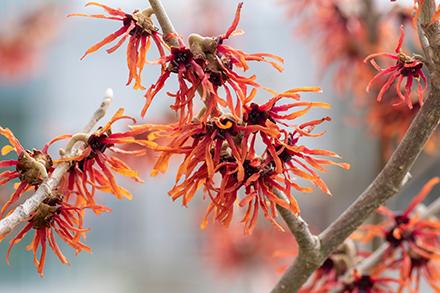Witch Hazel Spells Trouble for Harmful Microbes

Photo courtesy of Adobe Stock.
With stunningly vivid clusters that range from red to yellow, witch hazel is well-known as an ornamental plant that usually blooms just as temperatures begin to drop during the colder months of the year. However, the plant has more to offer than just its distinctive appearance; thanks to its natural astringent and antiseptic qualities, witch hazel is also a popular folk remedy used to treat a variety of ailments including acne and inflammation.
According to ARS research chemist Reuven Rasooly and his team with the Foodborne Toxin Detection and Prevention Research Unit, witch hazel’s exalted place in folk medicine isn’t just hype.
“Witch hazel has a high phenolic content, meaning that it contains special compounds capable of inhibiting both the growth and the virulence (severity) of pathogenic bacteria,” Rasooly said. “In our in vitro work with the plant, we tested and evaluated a tannin-rich witch hazel extract against several types of bacteria responsible for many human illnesses, including the bacterial families that cause strep and staph infections.”
The team discovered that the witch hazel extract was extremely effective in suppressing bacterial pathogenesis, or the ability of bacteria to further develop and produce detrimental toxins for secretion into the host environment. Rasooly explained that pathogenesis is the root cause of many persistent infections and accompanying complications.
Additionally, further research indicated that witch hazel could act as a great team player, working synergistically with other antibiotics to defeat harmful microbes, while also supporting the growth of ‘good bacteria’ in the gastrointestinal tract. For example, when in nutrient-poor environments, witch hazel promoted the growth of probiotic Lactobacillus plantarum, a bacterium commonly found in fermented foods and touted as a natural digestive aid. Most notably, natural gut flora remained relatively unaffected by the presence of witch hazel, which is important for maintaining homeostasis (an ideal state of equilibrium for health).
For consumers, witch hazel’s ‘smart’ antimicrobial properties make the plant a great way to fight bacterial pathogens, especially those that have notoriously developed resistance to conventional antibiotic treatments. These findings not only benefit consumers, but also farmers and growers looking to avoid or lessen dependence on conventional antibiotics while maintaining food safety along the supply chain. Rasooly and his team ultimately hope that their findings will help prevent excessive antibiotic use and the resulting rise of more ‘superbugs.’ – by Georgia Jiang, ARS Office of Communications.

